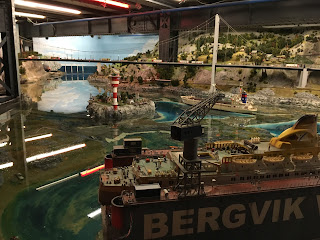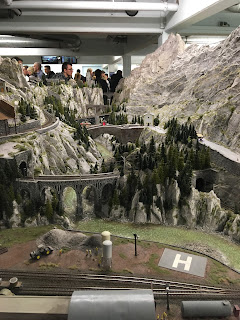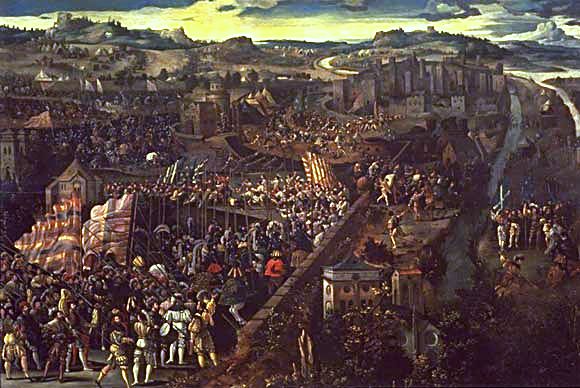Saturday November 4th dawned and we assembled at Broughton for our next "push of the envelope" operational game. Not enough of us were available to do the desert encounter battle, so instead we made the most of the opportunity to have a go at transporting an earlier period to the operational format. The Renaissance seemed the easiest period to attempt, and if successful, we would have a new mini-campaign system for our other pre-20th century periods. I have to say, I think it played very well!
The original proviso was that the Duke of Ferrara, a close ally of the Pope (as played in our epic Renaissance campaign of nearly two years ago) is besieged by his aggressive neighbour, Venice. Keen to aid his ally, the Pope has despatched an army of relief to save the city of Ferrara, and if possible, defeat the army of Venice - see previous post for the rules.
Jon, who had played the Pope in the previous campaign, assumed command of the Papal forces assisted by Russ, and likewise, Mark took charge of the Venetians with the help of Frank.
The initial plans for both sides were very well thought out, and I think for a first foray into a new period, very bold. I do think familiarity with the tables has sped up decision making and generalship.
The Papal plan was to march quickly to the aid of Ferrara along 1D and 2D and assemble outside the walls of the city on 3B. This would allow the army to operate with supplies from the city or attack the Venetian siege lines on 3A by marching through the city. The Duke of Ferrara had a strong garrison that was largely poised along the walls of 3A to either pin the besieging Venetian force or sally out in support of the main Papal force.
 |
| The Duke of Ferrara, aware that a Papal army of relief is approaching , lines the ramparts of his city in readiness for a sortie against the Venetian siege lines. |
The Venetians were aware of the strong garrison and had deployed a powerful force of artillery and infantry within the siege works. However, the bulk of their army was deployed on 2B, well placed to assist the besiegers on 3A, defend against a Papal attack that would have to deploy piece meal through the difficult ground on 2C, or counter any Papal thrust along 1A and 2A. Mark boldly detached his C in C with all his light cavalry to act as a trigger on 1B as he felt the most likely Papal attack would be along the "A" tables. As an insurance he placed a small garrison in the fort on 1C and another detachment dug in at the bridge on 2B. A dummy base was placed on 2C.
The Papal army was strong in Condottieri and Retainers and Russ commanded the Swiss Pike (which was of no surprise at all to Mark and Frank!). Anticipating this, the Venetians had hired Landsknechts - 6 units! - which they hoped would lure the Swiss onto superior numbers or into poor tactical situations.
The Papal plan rolled out over the first few turns whilst the Venetians looked on and tried to gauge the main thrust of the attack. Pleased that he had got his army unmolested to 3B, Jon quickly despatched Russ and his Swiss through Ferrara with attack orders against the Venetian baggage - no dithering there as an unbelievable swathe of sixes enabled easy passage and plenty of movement!
 |
| Swiss Pike arrive on 3A with orders to attack the Venetian baggage. |
Meanwhile Mark moved his C in C from 1B to 1D to look as threatening as possible in conjunction with his dummy board on 2C as he still believed the most likely avenue of attack would be via 2C. Unfortunately, he was insistent on referring to this board as "my C in C" and Jon, sensing an opportunity to cause chaos in the Venetian command and control despatched his heavy cavalry to engage this, as yet, undisclosed movement board.
 |
| Mark's light cavalry on the right turn tail and run as the Papal host romps onto 1C. |
Mark only just managed to extricate his command from this powerful attack, literally keeping one move ahead of the Papal men at arms. The garrison on 1C, shooting from the fort's ramparts vainly attempted to slow Jon's cavalry down but the speed of Mark's light horse saved him from annihilation.
Meanwhile, the Swiss with the close support of the Duke's garrison is attacking the Venetian siege lines. Raked by Venetian light guns they ignore their casualties and storm into the defences. The Venetian front line buckles and a battery of artillery routes but Mark has a second line which counter attacks and pushes the Swiss back.
Aware that the main Papal attack is on 3A, Mark has made it back to his main force on 2B and orders Frank with the majority of the Landsknechts to move to 3A. I think that this is one of the pivotal decisions of the game; intending to keep his options open, Frank is ordered to the hill on 3A rather than attack the Swiss. Does this allow a considered attack against the flank of the emerging Papal army or does it incur further delay whilst the Venetian C in C is busy elsewhere? - we will see.
 |
| Jon's uncommitted C in C languishes outside the walls of Ferrara on 3B as a rut of 1's and 2's prevents him changing his orders. |
At the same time, Mark has ordered his dummy board on 2C to take 2D, cut off the aggressive Papal cavalry and look threatening against the Papal C in C on 3B. With the success of the Venetian infantry against the Swiss Pike it looks like the battle has swung back to Mark and Frank.
 |
| Russ' Swiss are held and even pushed back across the siege lines. Frank's force of Landsknechts with supports has arrived at the hill on 3A. |
However, the Swiss setback is temporary, and Russ reorganised his veteran units to renew the assault, with one pike block punching through a crossbow unit and into the Venetian baggage. Frank's Landsknechts arrive on 3A but with orders to hold the hill they are unable to intervene against the vulnerable Swiss flanks. The Duke detaches mounted crossbow to harry this new threat and delay the Germans from intervening.
 |
| Frank's troops hover on the flanks but the Swiss are already looting the baggage and the remaining Venetian foot are struggling to contain the onslaught. |
Whist the battle develops on 3A, Jon (after 5 turns of failing to change his own orders) has managed to move his C in C through 2C, opening up supply lines and communication with his cavalry on 1B, and has emerged from the close terrain to hit Mark's C in C in the flank on 2B. Mark struggles to extricate his command whilst sending the necessary orders to Frank to attack the Swiss.
 |
| Another shot of Frank's troops moving to the attack as the Duke of Ferrara and one Swiss Pike block turn to face this new threat. |
The Venetian light cavalry is no match for the armoured Papal horse and casualties begin to mount threatening to force the C in C's command on hold. The Venetian foot on 3A have reached 50% casualties and have already dropped the aggression level of the Venetian army. To emphasise the Swiss ascendancy, the Venetian sub-commander has met an heroic death attempting to stem the surge of pike. Frank's Landsknecht's struggle to effectively intervene against the Swiss and the Papal heavy cavalry have succeeded in accepting new orders to take 1A and then charge down 2A into the exposed Venetian baggage as the bridge guard on 2A has been withdrawn to help in the entrenchments.
 |
| The small but effective Papal command base (on the right) arrives on 2B |
 |
| The next turn, it's two heavy cavalry units smash into the Venetian light horse. The movement board is a powerful force of Venetian foot and cavalry but Mark's C in C is too busy to send it orders. |
 |
| The Papal cavalry has now crossed the river on 2A and is poised to take the undefended baggage on 3A. |
After 21 turns the battle came to a close with a 11 to 7 victory for the Pope and Venetian army morale faltering. It must be admitted that Russ and Jon rolled a lot of 6's which meant movement and orders were swift. There was one notable exception when Jon struggled to order his C in C to attack 2B and the heavy cavalry were in danger of romping after Mark's C in C and onto the prepared positions of the main Venetian force. However, on the whole the Papal orders were simple and direct and I think the Swiss and the Duke Ferrara required only one order change each for the whole battle.
Venetian dispositions were good and the initial plan sound. Detaching the C in C was a calculated risk, especially towards the end of the game when bolder orders were required for the Landsknechts. However, the initiative was always going to be with the Pope until the Venetians were sure of the main line of attack. I wonder whether both sides took too much of a risk dividing their forces, although I would say Jon and Russ won through bolder and more decisive orders.
As an operational game it worked very well. The sense that a battle could be fought at any number of points kept both sides careful with reserves and over commitment of forces - it did feel like a mini campaign. All the tables were moved over and there were actions fought on three of them. The size of the armies at equal points felt correct and the game was in the balance right until the end. No one played badly and as Umpire I had a great game watching two teams manoeuvre their armies and "duke" it out - well done everyone!

































